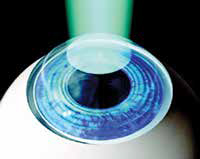How big should a SMILE be to not cause dryness?
Servet et al evaluated the influence of incision size on dry eye symptoms in the small incision lenticule extraction (SMILE) procedure. They enrolled 94 eyes of 47 patients with myopia and/or myopic astigmatism who had undergone the SMILE procedure in this study. The patients were divided into 3 groups according to the incision size (2, 3, and 4 mm) applied during the SMILE procedure. There were no significant differences among the groups in respect to age and sex (P values 0.251 and 0.974, respectively) and in respect to preoperative, postoperative first day, first week, first month, third month, and sixth month values of the Ocular Surface Disease Index score, tear break-up time, ST1, and staining grades. The authors thus concluded that there was no difference in dry eye symptoms with 2-, 3-, and 4-mm incisions. In the learning period of SMILE surgery, larger incision sites can be used to make the procedure easier.
Read More:
Servet C et al. Influence of Incision Size on Dry Eye Symptoms in the Small Incision Lenticule Extraction Procedure. Cornea 2019;38(1):18-23
Corneal surface ablation surgeries: Which one outperforms?
Wen D et al systematically compared the efficacy, predictability, safety, postoperative haze, pain scores, and epithelial healing time of four corneal surface ablation procedures in a metaanalysis. Their thorough methodology involved searching PubMed, Embase, Cochrane Library, and the U.S. trial registry for articles on this subject up to June 2018. To ensure best possible data, only randomized controlled trials were selected. Efficacy (uncorrected distance visual acuity of 20/20 or better), predictability (refractive spherical equivalent within ±0.50 diopters [D] of the target), and safety (loss of two or more lines of spectacle corrected distance visual acuity) were set as primary outcome measures. Haze, pain scores, and epithelial healing time were set as secondary outcome measures. The authors found 18 qualifying studies involving 1,423 eyes and included them. According to the Grading of Recommendations Assessment, Development, and Evaluation, the quality of outcomes were moderate to high (70.6%). There were no differences in efficacy, predictability, safety, haze, day 1 pain, and epithelial healing time between treatments. Epithelial laser in situ keratomileusis (epi-LASIK) had statistically significantly higher pain scores on day 3 compared to photorefractive keratectomy (PRK) (weighted mean differences [WMD] = 2.2, 95% credible intervals [CrI] = 0.19 to 4.01) and transepithelial PRK (T-PRK) (WMD = 2.7, 95% CrI = 0.51 to 4.84). The surface under the cumulative ranking curve ranking results (best to worst) showed laser epithelial keratomileusis (LASEK) ranked highest for efficacy, predictability, safety, and day 1 pain scores. Epi-LASIK ranked best for grade 1 haze scores. T-PRK ranked best for haze of 0.5 or higher, haze scores day 3 pain scores, and epithelial healing time. The authors concluded that all surface laser refractive surgeries are comparable in terms of efficacy, predictability, safety, and postoperative haze except for day 3 pain scores, with epi-LASIK being more painful compared to PRK and T-PRK.
Read More:
Wen D et al. Corneal Surface Ablation Laser Refractive Surgery for the Correction of Myopia: A Network Meta-analysis. J Refract Surg. 2018 Nov 1;34(11):726-735.
